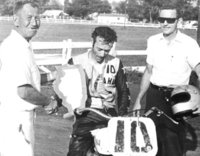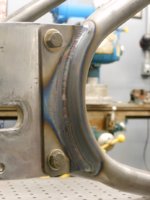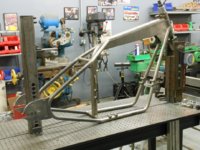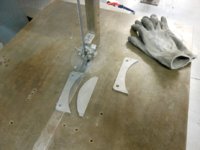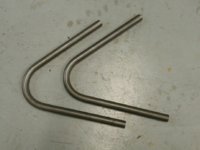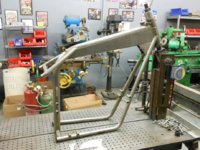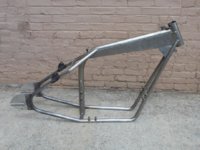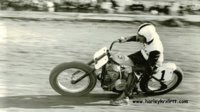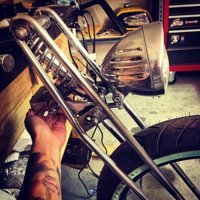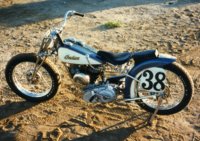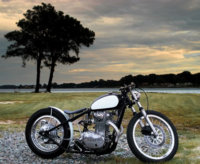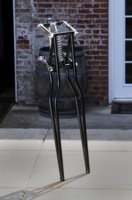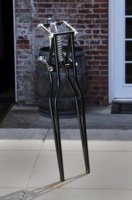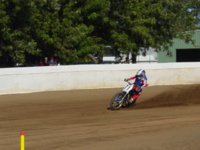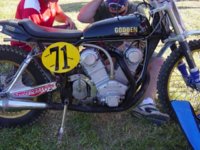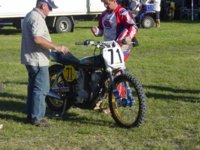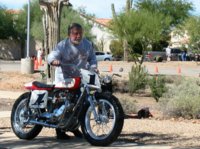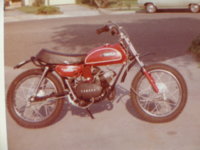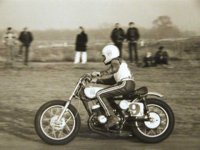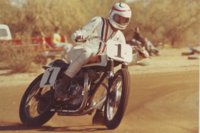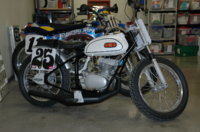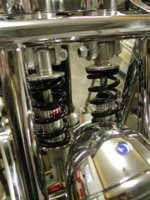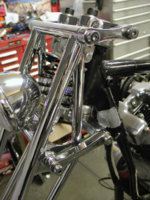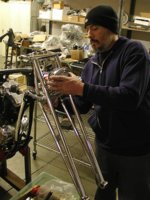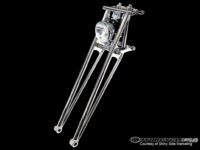Jeeter
XS650 Addict
The YZ650 - Cheney Engineering rigid frame project (father/son tribute)
This project bike is based on the very rocky relationship I had with my stepdad of 30~ years (he died in 1999). He raced flat track in the 1950s and 1960s, and he of course taught me to ride and race. I'll post a more detailed explanation of all of that in post #2. So that way if you wish to skip all of that "Cats in the Cradle" crap from a 53 year old you can just roll right past post #2.
The Triumph below is probably pretty close to what I have in mind. Street legal, modern brakes and tires, shouldered Akronts, vintage vibe.
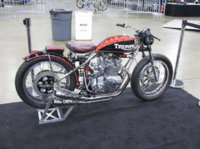
I'm basing this bike on a racing frame that was built specifically for hard core flat track racing by a company known as "Sonic Weld", all of which were rigid frame (aka "hard tail") designs much like a Speedway bike uses. It turns out that the rigid rear end is the cat's pajamas for getting around a dirt oval ~toot sweet~. So Sonic Weld designed and built hardtail flatrack frames up to 1968. In 1968 the AMA outlawed the used of aftermarket racing frames that had no rear suspension for flat track racing (aka "Class C"). The AMA felt that the bikes were becoming too much like "Class A" Speedway bikes and they wanted to keep a solid difference between the two racing types. That same year the proprieters of Sonic Weld parted ways over differences between them over which direction the company should take in the future. The two main fabricators at Sonic Weld ended up creating their own separate companies. Ray Hensley went on to create Trackmaster, and Ken Watkins went on to create Red Line.
The original Sonic Weld competition rigids had their geometry worked out by a fella known as Neil Keen. Neil was a dominator at Ascot in the early 1960s, winning a long string of main events. Neil ended up doing the material purchasing for Sonic Weld in the early stages of the company.
So the Sonic Weld competition rigids have a rich history in flat track, so much so that Cheney Engineering makes Sonic Weld ~type~ rigid frames for a number of different engine configurations, including the Yamaha XS650. The frame pictured below is the actual Cheney Sonic Weld tracker frame for the Yamaha XS650 vertical twin engine. Each frame is built around a set of design specs to suit the exact engine the end-user wishes to install. So you know you're not getting some sort of "one size fits all" set up.
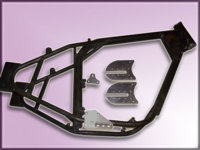
LINK TO CHENEY ENGINEERING - http://www.cheneyengineering.com/frame.shtml
In a nutshell the project bike will essentially be a hardtail street tracker, using a Sonic Weld frame hand made at Cheney Engineering and corrently configured to use the XS650 (as far as engine placement and relevant geometry is concerned). Yea, it's about $1,100 for the frame but it comes with CNC machined engine mounts, footpeg mounts, rear brake master cylinder plates, rear axle, rear axle plates with adjusters that offer 2 full inches of front/rear adjustment, Timkin steering head bearings and seals (with a headstock to fit any front end you wish). The frames are all made of 4130 CrMo, and are beautifully tank-blasted (a giant tank full of abrasive media that vibrates, like a rock tumbler sorta) that removes all welding slag and other little bits. When the frame arrives it is nearly ready for nickle plating. Also consider that with the rigid there is at least $1,000 in racing shocks that do not need to be purchased, as well as the swingarm and pivot bearings. In all the rigid works out to be about $2k less than a bike with rear suspension. So there's that.
I have no solid ideas on engine mods or rebuilding ideas. Same with front suspension and other details like that. That stuff will all come. The first thing was to work out the frame's details and decide on the XS650 engine (which was suggested to me by Jerry Cheney over the Harley engine due to the HD's engine is too heavy, too expensive, and not shaped properly to allow for the 49.5% front weight bias. The HD engine also requires more wheelbase to acomodate the physically larger Sportster engine. So he is unable to make a Sonic Weld frame with the prefered 54 inch wheelbase when using a Harley engine. Now, he'll build whatever the customer wants. So if I had wanted to stick with the HD engine Jerry would have obliged. He has a policy of making a suggestion just once. If the customer says that they'd rather stick with their own ideas then he'll oblige without any problems. But after he told me why he liked the Yamaha engine (many reasons) I looked into that engine and discovered he was absolutely correct. So here I am.
Cheney carries all of the hubs, brakes, brake levers, footpeg kits, and so on and so on. So, I can either go with caliper mounts and other brake components of my own choice or I can go with what they offer. They also have hubs, wheels, spokes, triple clamps, various CNC mounts and such, footbrake levers, discs, adapters, on and on. So a person can either use their stuff or stuff like that from any other source if one prefers it.
Ok, enough boring the hell out of you all. The pictures attached represent some Sonic Weld flat trackers, and a few pics are very close to what I wish to build here.
More to come soon. I'm ordering the frame either this week or next week. After that I'll figure out how I wish to proceed (do I buy cases and build an engine up, do I buy a running engine, do I buy an entire bike that I can remove the engine from and eBay off the rest???, bla bla bla. Sometimes opportunities arrise that can change your plans, we bought a Yamaha XJ650 Maxim that needed a little work for forty bucks once! We only needed the engine so we eBay'd the rest of the bike and made a nice little bit of cash to use for the project bike). Thanks!
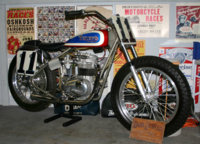
(BELOW) That's one sweet ass Honda CB450 hard tail flat tracker!
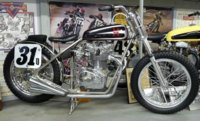
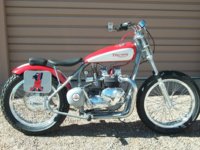
Below is a Cheney Sonic Weld frame with a Triumph engine. I'm guessing the frame for the XS650 will look similar to this one.
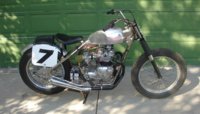
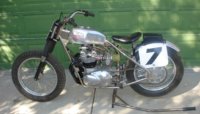
After the frame arrives here in my shop I'll need to TIG weld on some various tabs and brackets for minor stuff (ignition box, seat mounts, and so on). The plan is to eventually Nickel plate the frame once the fabbing is finished. Paint scheme? Who knows just yet. There are many details that will need to be worked out. The main thing was getting the frame/engine combination decided upon. All of that other stuff will work out easily enough.
This project bike is based on the very rocky relationship I had with my stepdad of 30~ years (he died in 1999). He raced flat track in the 1950s and 1960s, and he of course taught me to ride and race. I'll post a more detailed explanation of all of that in post #2. So that way if you wish to skip all of that "Cats in the Cradle" crap from a 53 year old you can just roll right past post #2.
The Triumph below is probably pretty close to what I have in mind. Street legal, modern brakes and tires, shouldered Akronts, vintage vibe.

I'm basing this bike on a racing frame that was built specifically for hard core flat track racing by a company known as "Sonic Weld", all of which were rigid frame (aka "hard tail") designs much like a Speedway bike uses. It turns out that the rigid rear end is the cat's pajamas for getting around a dirt oval ~toot sweet~. So Sonic Weld designed and built hardtail flatrack frames up to 1968. In 1968 the AMA outlawed the used of aftermarket racing frames that had no rear suspension for flat track racing (aka "Class C"). The AMA felt that the bikes were becoming too much like "Class A" Speedway bikes and they wanted to keep a solid difference between the two racing types. That same year the proprieters of Sonic Weld parted ways over differences between them over which direction the company should take in the future. The two main fabricators at Sonic Weld ended up creating their own separate companies. Ray Hensley went on to create Trackmaster, and Ken Watkins went on to create Red Line.
The original Sonic Weld competition rigids had their geometry worked out by a fella known as Neil Keen. Neil was a dominator at Ascot in the early 1960s, winning a long string of main events. Neil ended up doing the material purchasing for Sonic Weld in the early stages of the company.
So the Sonic Weld competition rigids have a rich history in flat track, so much so that Cheney Engineering makes Sonic Weld ~type~ rigid frames for a number of different engine configurations, including the Yamaha XS650. The frame pictured below is the actual Cheney Sonic Weld tracker frame for the Yamaha XS650 vertical twin engine. Each frame is built around a set of design specs to suit the exact engine the end-user wishes to install. So you know you're not getting some sort of "one size fits all" set up.

LINK TO CHENEY ENGINEERING - http://www.cheneyengineering.com/frame.shtml
In a nutshell the project bike will essentially be a hardtail street tracker, using a Sonic Weld frame hand made at Cheney Engineering and corrently configured to use the XS650 (as far as engine placement and relevant geometry is concerned). Yea, it's about $1,100 for the frame but it comes with CNC machined engine mounts, footpeg mounts, rear brake master cylinder plates, rear axle, rear axle plates with adjusters that offer 2 full inches of front/rear adjustment, Timkin steering head bearings and seals (with a headstock to fit any front end you wish). The frames are all made of 4130 CrMo, and are beautifully tank-blasted (a giant tank full of abrasive media that vibrates, like a rock tumbler sorta) that removes all welding slag and other little bits. When the frame arrives it is nearly ready for nickle plating. Also consider that with the rigid there is at least $1,000 in racing shocks that do not need to be purchased, as well as the swingarm and pivot bearings. In all the rigid works out to be about $2k less than a bike with rear suspension. So there's that.
I have no solid ideas on engine mods or rebuilding ideas. Same with front suspension and other details like that. That stuff will all come. The first thing was to work out the frame's details and decide on the XS650 engine (which was suggested to me by Jerry Cheney over the Harley engine due to the HD's engine is too heavy, too expensive, and not shaped properly to allow for the 49.5% front weight bias. The HD engine also requires more wheelbase to acomodate the physically larger Sportster engine. So he is unable to make a Sonic Weld frame with the prefered 54 inch wheelbase when using a Harley engine. Now, he'll build whatever the customer wants. So if I had wanted to stick with the HD engine Jerry would have obliged. He has a policy of making a suggestion just once. If the customer says that they'd rather stick with their own ideas then he'll oblige without any problems. But after he told me why he liked the Yamaha engine (many reasons) I looked into that engine and discovered he was absolutely correct. So here I am.
Cheney carries all of the hubs, brakes, brake levers, footpeg kits, and so on and so on. So, I can either go with caliper mounts and other brake components of my own choice or I can go with what they offer. They also have hubs, wheels, spokes, triple clamps, various CNC mounts and such, footbrake levers, discs, adapters, on and on. So a person can either use their stuff or stuff like that from any other source if one prefers it.
Ok, enough boring the hell out of you all. The pictures attached represent some Sonic Weld flat trackers, and a few pics are very close to what I wish to build here.
More to come soon. I'm ordering the frame either this week or next week. After that I'll figure out how I wish to proceed (do I buy cases and build an engine up, do I buy a running engine, do I buy an entire bike that I can remove the engine from and eBay off the rest???, bla bla bla. Sometimes opportunities arrise that can change your plans, we bought a Yamaha XJ650 Maxim that needed a little work for forty bucks once! We only needed the engine so we eBay'd the rest of the bike and made a nice little bit of cash to use for the project bike). Thanks!

(BELOW) That's one sweet ass Honda CB450 hard tail flat tracker!


Below is a Cheney Sonic Weld frame with a Triumph engine. I'm guessing the frame for the XS650 will look similar to this one.


After the frame arrives here in my shop I'll need to TIG weld on some various tabs and brackets for minor stuff (ignition box, seat mounts, and so on). The plan is to eventually Nickel plate the frame once the fabbing is finished. Paint scheme? Who knows just yet. There are many details that will need to be worked out. The main thing was getting the frame/engine combination decided upon. All of that other stuff will work out easily enough.
Last edited:

